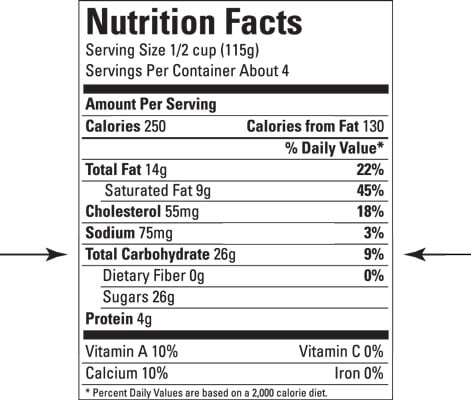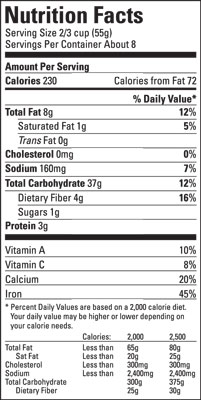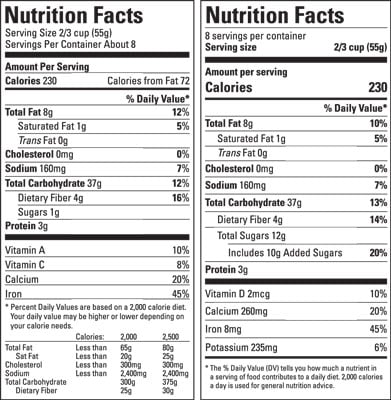You want to focus on the grams of carb, not the %Daily Value, because insulin dosing is based on the actual grams of carb, not the percent. Carbohydrate grams and %Daily Value are listed on the same line on Nutrition Facts labels, as you can see here.
Because %Daily Value is written in bold and off to the right side of the label, and lined up neatly with the actual amount, it is easy to allow your eye to zero in on the %Daily Value rather than the actual amount in grams. However, knowing that you're getting 26 g of carbohydrate is far more important than knowing that you're getting 9% of the Daily Value for a person who should be eating 2,000 calories per day. (That is, unless you're in the subset of people who happen to need exactly that many calories and therefore fall into the "reference range.")
The %Daily Value on the Nutrition Facts label is useful when you're trying to determine whether a product is high or low in a given substance. Note that 5%DV or less is considered low in that nutrient, and 20%DV or more is considered high in the nutrient. When looking at total fat, saturated fat, cholesterol, and sodium, it pays to choose foods that are low (5%DV or less). When looking at fiber, vitamin A, vitamin C, calcium, and iron, it is a good idea to aim for choices that are high (20%DV or more).
Viewing versions of traditional food labels
Several versions of the Nutrition Facts labels are currently in use. The most extensive label includes additional information at the bottom of the label. This footnote section is often a source of confusion. This figure points out the lower segment of the label, which provides the reference information in a footnote.Notice that target intakes are provided for two calorie levels. One column heading is for a 2,000-calorie intake target, and another column heading is for a 2,500-calorie intake target. Total fat, saturated fat, cholesterol, sodium, total carbohydrate, and fiber daily targets are set for the two reference calorie levels.
The upside of this information is that it allows consumers to have a rough idea of what intake targets to aim for in a day. The downside is that lots of people simply don't fall into those calorie target ranges.
An abbreviated version of the food label is also acceptable for manufacturers to use. Some food packages use a version that omits the footnote details from the bottom of the label and simply provides the key nutrition facts.
Taking a sneak peek at newfangled food labels
The current food label imagery has been in use for more than 20 years. The Nutrition Facts label has recently been redesigned, revamped, and improved. Changes reflect the latest scientific, nutrition, and public-health research. Health experts and the general public provided feedback, which helped shape the label transformation. The new design should make it easier for the public to make informed decisions about what they are consuming. Manufacturers have some time to gear up and get the new image rolling, but they are mandated to go live by July 2018. Smaller companies have an additional year to make the changes.This figure shows the old and the new, in a side-by-side view. The label on the left is the design currently in print. The label on the right is the sneak peek of the upcoming new and improved label.
Here's the scoop on what you can expect to see:
- More realistic serving sizes: The first line on the new label specifies the number of servings in the container. Suggested serving sizes have been reconsidered on various foods. Changes have been made so that suggested serving sizes will be more likely to reflect actual intake. For example, the serving size on the new label will reflect the reality that a 20-ounce beverage is likely to be sucked down by one person, not 2.5 people. However, a 12-ounce beverage will also indicate that the container holds one serving. Let's be honest; most of us don't tend to share our beverages, and once the beverage is opened, it's usually finished off in one sitting.
- Per serving versus per package notation: Some labels will provide dual columns to show nutrition information for per serving as well as per package. For example, if you eat the whole pint of ice cream, you'll be able to easily identify calories and nutrition facts for not only one portion but also the full container. Being more aware may help people to limit their intake to the suggested "one serving."
- Bigger, bolder serving-size and calorie fonts: Looking further at the new label design, on the right, you may notice how the serving size will be noted in large, bold font. The calorie level will be in even larger and bolder font. They want to make sure everyone knows that one large bag of potato chips isn't a single-serving container.
- No inclusion of calories from fat: The calories from fat will no longer be listed. There will still be a requirement to identify the Total Fat grams and the amount of unhealthy Saturated and Trans Fats.
- Specification of "added" sugar: One significant change coming to the new label relates to sugar. Current labels already list the amount of sugar in the product, but the new food label will add more clarity. It will not only list the total amount of sugar per serving, but it will also tell you how much of the sugar is "added" versus naturally present in the food.
Added sugars are going to be identified on the new labels to help consumers be more aware. Added sugars, honey, syrup, and other processed sweeteners tend to add too many "empty calories." Those calories, if not kept in check, can lead to unwanted weight gain and a rash of other health concerns, not to mention the impact on blood-glucose control if you have diabetes.
- Updated %Daily Value targets: Daily values for nutrients like sodium, fiber, and vitamin D are being updated based on newer scientific evidence from the Institute of Medicine and other reports such as that from the 2015 Dietary Guidelines Advisory Committee.
- Inclusion of micrograms and milligrams for vitamins and minerals: Old labels fall short, as they currently list only the %Daily Value for vitamins A and C and for the minerals calcium and iron. Current labels don't indicate exactly how many milligrams of calcium, for example, are provided. The new labels will continue to list information on calcium and iron, and will start to list the specific amounts in milligrams in addition to the %Daily Value.
- Addition of vitamin D and potassium info: Another notable change will be the addition of vitamin D and potassium information:
- Vitamin D is critical for bone health, and lab results are showing that many of the people who are being screened have low blood levels of this crucial vitamin. Vitamin D content will be listed in micrograms and in %Daily Value.
- Listing potassium on the new label will bring more attention to this important mineral, which, among other things, helps with blood-pressure regulation. Potassium content will be listed in milligrams, which will be useful for individuals with kidney failure who need to limit or track their intake of potassium. The %Daily Value will also be listed.
- Omission of vitamins A and C: New labels will no longer be mandated to include details on vitamin C and vitamin A. You may wonder why those two nutrients are being booted off the new label. It's simply because deficiencies are far less frequent these days as most individuals have adequate intakes for both vitamins A and C.




